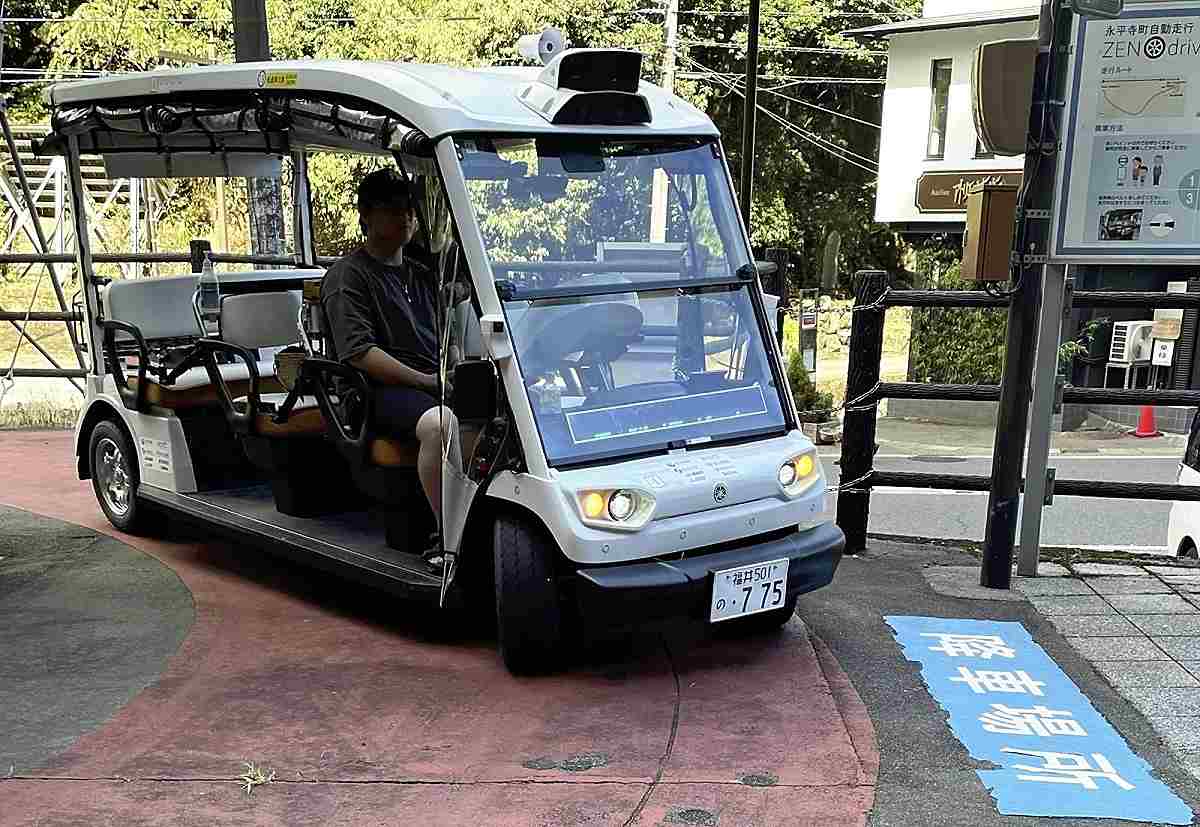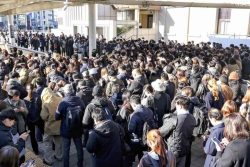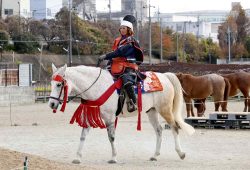
A self-driving electric cart in the town of Eiheiji, Fukui Prefecture
18:04 JST, June 3, 2024
EIHEIJI, Fukui (Jiji Press) — Technical and financial problems have been identified in the year since Japan’s first transportation service using so-called Level 4 autonomous driving began in the town of Eiheiji, Fukui Prefecture.
Amid the country’s declining population, Level 4 autonomous driving, or fully automated driving under certain conditions, is viewed as a promising means of transport. The service in the central Japan town, however, has shown hurdles that must be cleared.
On May 28, 2023, the service was launched on a 2-kilometer section of a walkway in Eiheiji. It is available only on Saturdays, Sundays and national holidays.
A one-way trip on a seven-seat vehicle, with a top speed of 12 kilometers per hour, takes around 10 minutes.
Level 4 operations became possible on public roads and ways when the revised road traffic law went into effect in April last year. A public-private entity in Eiheiji became the first in Japan to obtain permission for such operations, in order to run the autonomous service in the town.
According to the town and others, 1,348 people, mainly tourists, had used the service as of April this year. Many company and local government officials have visited the town to inspect the service.
In October last year, an accident occurred in which a Level 4 vehicle hit a pedal of a parked bicycle. While none of the passengers were hurt, the service was suspended.
The incident happened because the vehicle’s camera failed to recognize the bicycle.
The service resumed in March this year after measures were taken to improve the visual recognition performance of the vehicles.
“It would be good if (the Level 4 service route) reaches supermarkets and hospitals in the future, but (the self-driving vehicles) are different from cars and buses in that they are slow,” said Ryuji Inoue, 61, a restaurant industry worker in the town who has used the service.
The central government hopes to make transportation services using autonomous vehicles available at 50 locations across the country by fiscal 2025, viewing such services as essential to maintaining regional public transportation networks and tackling driver shortages.
At present, Level 4 vehicles cannot cross intersections due to technical and legal problems.
“It’s necessary to introduce some flexibility” in the permit system for Level 4 services, including by allowing the person managing operations to decide whether to allow autonomous vehicles to cross intersections, an Eiheiji town official said.
Another headache for the Eiheiji service is how to secure profitability. In line with the costs of public transportation services in the area, the fare for the Level 4 service is set at ¥100 per adult.
The fare is “not nearly enough to cover our operating costs,” an official of the service’s operator said. The operator is considering offering an image-viewing service to passengers and charging a fee on top of the fare.
Kanazawa University associate professor Kensaku Tanaka, an expert on transportation geography, said that autonomous driving “may contribute to reducing the labor needed to operate transportation services and streamlining transportation systems.”
“The central government, local governments and service operators need to hold discussions with local residents and present their visions on what kind of community they aim to build in order to realize use that suits local needs,” Tanaka added.
"Society" POPULAR ARTICLE
-

Tokyo Zoo Wolf Believed to Have Used Vegetation Growing on Wall to Climb, Escape; Animal Living Happily after Recapture
-

JAL, ANA Cancel Flights During 3-day Holiday Weekend due to Blizzard
-

Snow Expected in Tokyo, Neighboring Prefectures from Jan. 2 Afternoon to Jan. 3; 5-Centimeter Snow Fall Expected in Hakone, Tama, and Chichibu Areas
-

Tokyo, Yokohama Observe First Snowfall of Season; 1 Day Earlier than Average Year
-

M6.2 Earthquake Hits Japan’s Tottori, Shimane Prefectures; No Tsunami Threat (Update 4)
JN ACCESS RANKING
-

Japan Govt Adopts Measures to Curb Mega Solar Power Plant Projects Amid Environmental Concerns
-

Core Inflation in Tokyo Slows in December but Stays above BOJ Target
-

Major Japan Firms’ Average Winter Bonus Tops ¥1 Mil.
-

Bank of Japan Considered U.S. Tariffs, Coming Shunto Wage Hike Talks in Its Decision to Raise Interest Rates
-

Tokyo Zoo Wolf Believed to Have Used Vegetation Growing on Wall to Climb, Escape; Animal Living Happily after Recapture


























